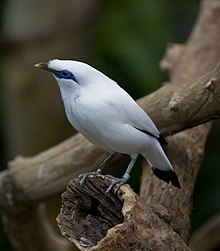Balistar
| Balistar | ||||||||||||
|---|---|---|---|---|---|---|---|---|---|---|---|---|

Balistar ( Leucopsar rothschildi ) |
||||||||||||
| Systematics | ||||||||||||
|
||||||||||||
| Scientific name of the genus | ||||||||||||
| Leucopsar | ||||||||||||
| Stresemann , 1912 | ||||||||||||
| Scientific name of the species | ||||||||||||
| Leucopsar rothschildi | ||||||||||||
| Stresemann, 1912 |
The Balistar or Bali-Mynah ( Leucopsar rothschildi ) is a highly endangered species of bird from the starling family (Sturnidae). It was discovered in 1910 and first described by the German ornithologist Erwin Stresemann in 1912 . The kind epithet honors the British nobleman and zoologist Walter Rothschild, 2nd Baron Rothschild .
features
The Balistar reaches a size of around 25 centimeters. The plumage is snow white with black wing and tail tips. The featherless skin of the face is blue. The eyes are dark brown. The beak is bluish gray with a yellow tip. The legs are grayish blue. There is a white feather hood on the head. Their diet consists of ants, termites and caterpillars, as well as fruits and seeds.
Breeding behavior
Little is known about the breeding behavior in the wild, but it is known from observations in captivity that the males react very aggressively to conspecifics. In American zoos, the pairs incubate between May and June and usually lay 3 to 4 eggs. The nests are created in woodpecker holes, crevices or nest boxes and padded with straw, twigs, grass and feathers. In the wild, the breeding season is in October / November.
Hazards and protective measures
At the time of its discovery in 1911, the Balistar was only living in a 50-kilometer-long coastal strip in the northwest of Bali. It is possible that the wild population never exceeded 900 individuals. In the 1970s, there were no more than 200 wild individuals, all of which were found in what is now Bali Barat National Park . At that point it became a criminal offense under Indonesian law to catch or sell Balistars.
The Balistar is in acute danger of extinction , especially due to deforestation in Bali and the now illegal animal trade. It is considered a highly sought-after cage bird, especially among wealthy Asians. In 1999 the black market price was around $ 2000 per bird. Although trade is prohibited under the CITES agreement, armed groups have repeatedly succeeded in appropriating animals born in human care and selling them on the black market due to corruption and poor administration. Inventory surveys are not easy because of the fluctuation. For example, Birdlife counted 6 birds in 2001. During an expedition in the only protected area, the Bali Barat National Park in Bali , where this species occurs, 24 specimens were counted in March 2004. In 2006, 37 Balistars were released into the wild in a bird sanctuary on Nusa Penida , an island off the southeast coast of Bali. Since this island has a drier climate than Bali, it was not certain that this release program would be successful. However, the Balistars adapted well to the local conditions and even began to nest in the tops of palm and fig trees, while on Bali they are cave-breeders who use caves created by other birds. Hundreds of Balistars now live on Nusa Penida.
The number of cages in Indonesia cannot be precisely determined due to the large number of illegal cages. In 1988 a conservation breeding program was founded by the Wuppertal Zoo and in 1993 the official conservation breeding program of the EAZA (EEP) was founded. The stock in the zoological gardens and partly in private hands is coordinated by the EAZA stud book keeper. The Cologne Zoo and the Halle Zoo are involved in conservation breeding and reintroduction into the wild . Financially, these measures are u. a. funded by the Association for Species Protection, Bird Keeping and Bird Breeding (AZ) eV .
literature

- Bruce Campbell : The Great Bird Book. Eugen Ulmer Verlag, Stuttgart 1976 (original title: The Dictionary of Birds in Color , German translation and adaptation by Klaus Ruge and Rainer Ertel), ISBN 3-8001-7025-6 .
- Dominic Couzens : Rare Birds - Survivors, Evolution Losers and the Lost. Haupt, Bern 2011 (original title: Atlas of Rare Birds , translated by Coralie Wink and Monika Niehaus , edited by Simon Papps). ISBN 978-3-258-07629-4 .
- Josep Del Hoyo , Andrew Elliott, David A. Christie : Handbook of the Birds of World. Volume 14. Lynx edicions, Barcelona 2009, ISBN 978-84-96553-50-7 .
Web links
- Nusapenida (website about the Balistar)
- Description at BirdLife International (English)
- Entry in the Red List of Indonesia (English; PDF file; 373 kB)
- Description at Stiftung Artenschutz
- List of German and European zoos that keep the Balistar .
- Leucopsar rothschildi in the endangered Red List species the IUCN 2008. Posted by: BirdLife International, 2008. Accessed October 25 of 2008.
- Videos, photos and sound recordings on Leucopsar rothschildi in the Internet Bird Collection
Individual evidence
- ↑ Couzens, p. 54.
- ↑ a b Couzens, p. 57.
- ^ Franz Robiller: The great lexicon of bird care / 1. A - K. 2nd edition. tape 2 . Ulmer, Stuttgart (Hohenheim) 2003, ISBN 3-8001-3195-1 .
